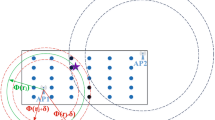Abstract
The huge distance measurement error in indoor areas and the difficulty of error estimation have posed great challenges to the design of practical TOA-based indoor geolocation systems. In this paper, we presented an RSS assisted TOA-based indoor localization algorithm, which uses RSS to estimate the range of DME for reference node selection and position estimation. This algorithm effectively improves the accuracy of distance measurement and position estimation, and thus improve the localization accuracy of the system. The algorithm is applied into a practical TOA-based indoor geolocation system, developed based on a commercially available device. The results of performance evaluation in a typical office environment show that the localization accuracy of our proposed algorithm is better than the conventional algorithms.












Similar content being viewed by others
References
K. Pahlavan, X. Li and J. Makela, Indoor geolocation science and technology, IEEE Communications Magazine, Vol. 40, No. 2, pp. 112–118, 2002.
N. Moayeri, J. Mapar, S. Tompkins and K. Pahlavan, Emerging opportunities for localization and tracking, IEEE Transactions on Wireless Communications, Vol. 18, No. 2, pp. 8–9, 2011.
S. Affes, N. Kandil, and C. Nerguizian, Radio-localization in underground narrow-vein mines using neural networks with in-built tracking and time diversity, 2011 IEEE Wireless Communications and Networking Conference (WCNC), Quebec, Canada, 2011.
W. H. Chen, H. H. Chang, T.-H. Lin, et al. Dynamic indoor localization based on active RFID for healthcare applications: A Shape Constraint Approach, BMEI, 2009.
D. Arnitz, U. Muehlmann and K. Witrisal, Wideband characterization of backscatter channels: derivations and theoretical background, IEEE Transactions on Wireless Communications, Vol. 60, No. 1, pp. 257–266, 2012.
S. Shiry, et al. Localization and approaching to the human by mobile home robot, The 9th IEEE International Workshop on Robot and Human Interactive Communication (IEEE-ROMAN), 2000.
K. Pahlavan, F. O. Akgul, et al., Indoor geolocation in the absence of direct path, IEEE Transactions on Wireless Communications, Vol. 13, No. 6, pp. 50–58, 2006.
M. Kanaan and K. Pahlavan, A comparison of wireless geolocalization algorithms in the indoor environment, IEEE Wireless Communications and Networking Conference (WCNC 2004), Atlanta, GA, USA, 21–25 March 2004.
P. Pivato, L. Palopoli and D. Petri, Accuracy of RSS-based centroid localization algorithms in an indoor environment, IEEE Transactions on Instrumentation and Measurement, Vol. 60, No. 10, pp. 3451–3460, 2011.
D. Dardari, A. Conti, U. Ferner, A. Giorgetti, et al., Ranging with ultrawide bandwidth signals in multipath environments, Proceedings of the IEEE, Vol. 97, No. 2, pp. 404–426, 2009.
F. Gustafsson and F. Gunnarsson, Positioning using time-difference of arrival measurements, IEEE International Conference on Acoustics, Speech, and Signal Processing, 2003.
J. B. Andersen and K. I. Pedersen, Angle-of-arrival statistics for low resolution antennas, IEEE Transactions on Antennas and Propagation, Vol. 50, No. 3, pp. 391–395, 2002.
I. Guvenc and C.-C. Chong, A survey on TOA based wireless localization and NLOS mitigation techniques, IEEE Communications Surveys and Tutorials, Vol. 11, No. 3, pp. 107–124, 2009.
I. Guvenc, C.-C. Chong, et al., NLOS identification and weighted least-squares localization for UWB systems using multipath channel statistics, EURASIP Journal on Advances in Signal Processing, 2007.
C. Duan, N. Alsindi, and J. Zhang, NLOS channel identification and mitigation in ultra wideband ToA-based wireless sensor net-works, Workshop on Positioning, Navigation and Communication (WPNC), March 2009.
M. Heidari, Identification and modeling of the dynamic behavior of the direct path component in ToA-based indoor localization systems, PhD Thesis, Worcest Polytechnic Institute (WPI), 2008.
J. He, Q. Wang, J. He, Q. Zhang, et al., A practical indoor TOA ranging error model for localization algorithm, 2011IEEE 22nd International Symposium on Personal, Indoor and Mobile Radio Communications (PIMRC),Toronto, 2011
N. Alsindi, K. Pahlavan, B. Alavi, and X. Li, A novel cooperative localization algorithm for indoor sensor networks, 17th Annual IEEE International Symposium on Personal Indoor and Mobile Radio Communications (PIMRC 2006), Helsinki, Finland, 11–14 Sep 2006.
J. He, Y. Geng, and K. Pahlavan, Modeling indoor TOA ranging error for body mounted sensors, 2012 IEEE 23nd International Symposium on Personal Indoor and Mobile Radio Communications (PIMRC), 2012.
N. Alsindi, B. Alavi and K. Pahlavan, Measurement and modeling of ultrawideband TOA-based ranging in indoor multipath environments, IEEE Transactions on Vehicular Technology, Vol. 58, No. 3, pp. 106–1058, 2009.
A. Bhatia, B. Mehta, and R. Gupta, Different localization techniques for real time location sensing using passive RFID, Technical Report, 2007.
Acknowledgments
This work is supported by National Science Foundation of P. R. China (No. 61172049, No. 61003251), Doctoral Fund of Ministry of Education (No. 20100006110015). The authors would like to thank Prof. Kaveh Pahlavan, Prof. Allen Levesque and Yishuang Geng from Center of Wireless Information Network Studies (CWINS), Worcester Polytechnic Institute (WPI) for their help on revising the paper.
Author information
Authors and Affiliations
Corresponding author
Rights and permissions
About this article
Cite this article
He, J., Yu, Y. & Wang, Q. RSS Assisted TOA-Based Indoor Geolocation. Int J Wireless Inf Networks 20, 157–165 (2013). https://doi.org/10.1007/s10776-012-0198-9
Received:
Accepted:
Published:
Issue Date:
DOI: https://doi.org/10.1007/s10776-012-0198-9




